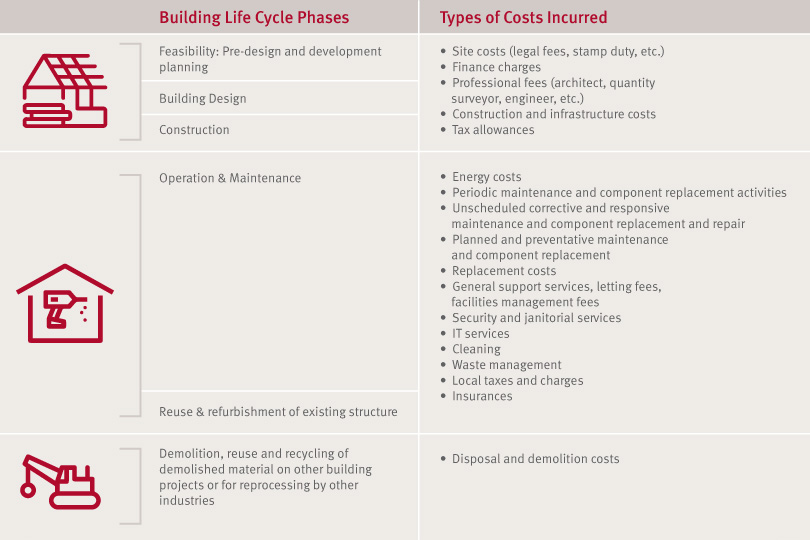Life Cycle Costing
“Life cycle costing (LCC) is a tool used for assessing the total cost performance of an asset over time, including the acquisition, operating, maintenance, and disposal costs.”
Davis Langdon, Management Consulting
Property owners and developers tend to pay more attention to the capital outlay required for building projects, with less emphasis on the operation and maintenance (O&M) costs incurred over the life of the asset.

LCC analysis reveals that 50-80% of the total costs occur during the in-service life of a building whereas approximately 25% accounts for the design and development activities. The table below illustrates the types of costs incurred during the different phases of the building life cycle.
Over a 30-50 year period, the costs of operating and maintaining a building are “typically in the broad ratio of 1 (construction costs) to 5 (maintenance costs) to 200 (cost of the operations being carried out in the building, including staffing costs).”
Managing Operations & Maintenance
O&M costs are heavily influenced by decisions made at the design phase of the building life cycle and therefore it is critical to conduct a LCC exercise during the design phase of a project and not at completion of the construction.
However, it can also be used to review existing buildings to assist with making procurement decisions.
Benefits of LCC:
• Provides clarity on future O&M costs and sensitizes owners/developers to the total project costs
• Enables planning for future capital expenditure required to maintain the building (e.g. sinking funds)
• Allows owners/developers to make informed decisions at the design stage that could reduce operating costs
• Enables owners/developers to calculate service charges
• Assists in budgeting and forward planning
• Ability to stage and optimise future costs at the design stage
Planning for O&M Costs
The importance of LCC should not be trivialised but should be a priority in the early stages of the design and development process similar to capital expenditure planning.
- Budgeting – developing budgets from first principles is key to ensuring that adequate funds are allocated to guarantee optimum building performance. This process is achieved by carrying out the following steps:
STEP 1: Identify all building systems/components that will require maintenance or incur operational costs.
STEP 2: Develop an asset register for those systems/components identified.
STEP 3: Determine the most appropriate maintenance strategy considering the building owner and occupant’s strategic objectives.
STEP 4: Develop a maintenance plan for all assets identified in alignment with the established maintenance strategy.
STEP 5: Identify all human, administrative and technical (e.g. specialist services, spares, supplies, etc.) resources required to facilitate the maintenance plan.
STEP 6: Obtain costs for step 5. - Sinking, Replacement and Reserve Funds – setting aside money over time for:
• The replacement of major plant and equipment (e.g. air-conditioning plant, generator and lifts) at the end of their useful life
• Expected future fluctuations or large one-off increases in operations
Conclusion
When LCC is conducted at the early stages of a building, significant cost savings can be realised over the asset life cycle. However, one must note that the benefits of LCC decline when conducted later on as the project progresses.



